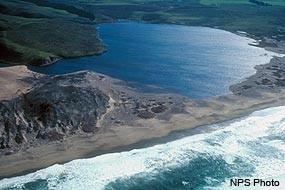Ecologists at Point Reyes National Seashore this month are experimenting with ways to remove non-native vegetation that is invading the habitat of native dune plants such as Tidestrom’s lupine
According to the park's website, "the seashore has embarked on a program of restoring its native dune systems and creating resilience to a critical and vulnerable ecosystem through removal of European beachgrass and iceplant, two species that impede natural dune movement and displace native dune plants and animals. These invasive species cover more than 1,500 acres of the coastal dune features along the Point Reyes peninsula. Restoration of the coastal dune habitats at Point Reyes will directly benefit five federally listed species."
Beginning this week crews were scheduled to be working on a small pilot dune restoration project approximately 1 mile south of Abbott’s Lagoon. "The pilot project would involve mechanical removal of European beachgrass (Ammophila arenaria) through excavation and burial and placement of a clean sand cap that is not contaminated with the highly viable rhizome fragments," according to a park release. "The project will essentially represent a pilot or initial phase designed to refine construction approaches and cost estimates for the larger project currently in development. It is anticipated to last approximately one week."
European Beachgrass was introduced to the coastal dunes at Point Reyes in the 1940s has taken over much of the dunes along the Great Beach and Limantour, according to park officials.
The pilot studies are to "test production rates and effectiveness of different mechanical treatment methods associated currently considered for large-scale removal of invasive European Beachgrass from the coastal dune habitat," according to park officials. "This work coincides with a larger scale restoration project to be conducted in Summer 2010."
Down the road seashore officials hope to expand the restoration work southward along the Great Beach and on the dunes that border Drake’s and Limantour Esteros.
For more details on the project, check out this site: http://www.nps.gov/pore/parkmgmt/planning_dunerestoration.htm#CP_JUMP_28...




Add comment